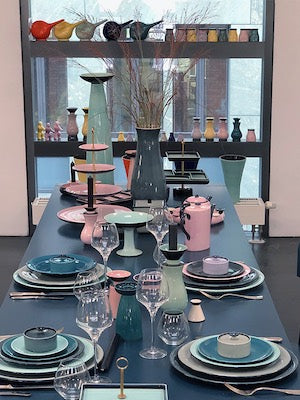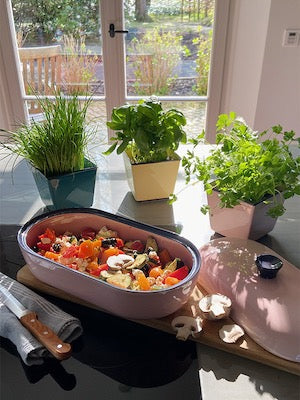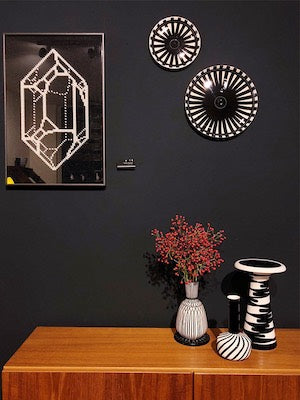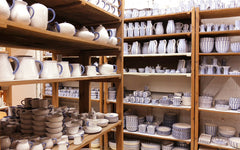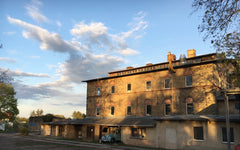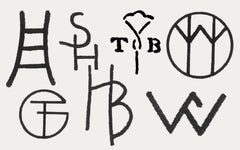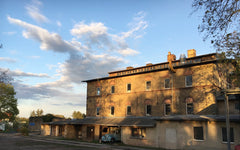
It begins with the careful selection of the raw materials and does not end when our ceramics come out of the oven. Many work steps are necessary before simple clay becomes unmistakable HB-Ritz ceramics, all of which are still carried out by hand in the workshops in Marwitz. Despite all experience, the burning process is still a work step with many variables that cannot always be fully controlled. But only the pieces that are perfect are sold at all, the rest are discarded. This is also why every piece is so unique, every piece of ceramics is unique.
Mass preparation

Before the sound can even be processed, it has to be processed. Because only careful preparation at the beginning guarantees first-class, flawless quality at the end. First, a clay granulate is mixed with water and mixed. A liquid, homogeneous mass is created, which is then further processed in a standing press. Depending on whether the clay is used for turning or as a casting slip, the press extracts more or less water from the mixture. In order for the clay to acquire the necessary plasticity, it is then stored in order to make clay. A vacuum press then extracts the oxygen from the material. After being stored again, the clay is sent through the press one last time – only then can it be further processed.
turning shop

Plates, bowls and cups are made in the turning shop by turning clay into or overturning a mould. A positive is produced with the help of a so-called template, the negative. Each part is made individually, piece by piece, by hand, then dries for three days before it goes onto the wheel again. Counterparts now help to plaster the ceramics and smooth out rough areas.
Free turning

Many pieces from the Hedwig Bollhagen workshops can neither be turned into molds, like plates or bowls, nor cast, like pots or jugs. Vases, for example, require full free spin crafting. The challenge here: each piece is unique, which is nevertheless produced in several copies in order to enable customers to purchase several of the same pieces.
Foundry

Everything that has an irregular shape is made in the foundry – i.e. pots, jugs, handles and figures. In order to produce these, casting slip is prepared from clay, which can be poured into plaster molds by hand. After the so-called shards have formed, the excess sludge is poured off and the body remains in the mold for another day. The cast body shrinks and can later be easily removed from the mold.
Putzerei

Precise manual work is also required in the fettling shop. Piece by piece, the blanks are freed from seams and edges. Lids are adjusted to fit perfectly, handles on cups or spouts on jugs are trimmed so they are easy to hold and won't come loose in everyday use. Finally, all parts are plastered so that previously existing seams are no longer visible.
First fire

The first firing, also called biscuit firing, takes place at 970°C or 1090°C. The workpieces remain in the oven for almost three days. The actual firing process only takes around 8 to 13 hours, the rest of the time the kiln cools down again.
Das Hedwig Bollhagen Ritz Decor

The scratch technique with which the Hedwig Bollhagen Ritz decor is created differs from the usual treatment of the workpieces right from the start, because the Ritz decor is applied before the first firing. The reason is simple: you can hardly scratch fired clay, the effort would be much too high. First you take raw shards and cover them with black engobe. The engobe works like a glaze, but does not shine. With a special tool, comparable to a scalpel, the black engobe is drawn back into the clay after application. Depending on the specification, the most elaborate decors and patterns are created. Only after this detailed manual work do the pieces go into the first firing, in order to then be glazed.
Second fire

A second firing is necessary. Again, the workpieces are carefully placed on a kiln car to be fired again. Only then are all the necessary work steps completed and quality control can check whether the work is 100% satisfactory.
final check

Also at the end of the manufacturing process there is manual work again. Because every piece that is manufactured in the Hedwig Bollhagen workshops is checked for possible errors before delivery by an employee who is familiar with all production steps. Only what fully meets our high quality requirements is sold at all. We know you expect quality, unique merchandise and we guarantee you'll get it.
